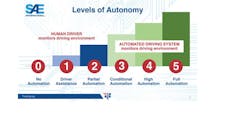Automated trucks
AUTONOMOUS, driver-less heavy-duty commercial vehicles are unlikely to become the new normal on America’s roadways, highways, and interstates anytime soon. Even less likely at this point would be driver-less autonomous vehicles hauling hazardous materials.
It is far more likely that we will see continued incremental development and application of technologies designed to improve vehicle safety and driver performance for the current generations of trucks. These technologies also will be critical for autonomous vehicles farther down the road.
This is the assessment of Mike Cammisa, vice-president of safety policy, connectivity, and technology for the American Trucking Associations. He discussed automated truck technology and future trends during the National Tank Truck Carriers Safety & Security Council’s annual meeting June 12-14 in Reno, Nevada.
He described key trucking industry trends that are influencing the push toward more automated trucks. For instance, the large truck fatal crash rate fell significantly over a 35-year period, from roughly 4.7 per 100 million miles in 1980 to 1.29 in 2015.
Increasing development and use of safety technology—including on-board driver monitoring systems, antilock braking, roll stability, collision avoidance, lane departure warnings, and on-board cameras—played a big role in cutting the number of fatal accidents. All of those technologies are critical for the automated vehicles.
Freight volumes are surging while the driver supply is shrinking. “We’re facing a shortage of 50,000 truck drivers this year,” Cammisa said. “One fleet operator joked recently that he already owns driver-less trucks. They are the ones parked at his terminal for lack of drivers.”
Autonomous and driver-less trucks certainly are making news these days. “We’ve seen a whirlwind of speculation on driver-less trucks, but it is important to remember that this technology is still very much in its infancy,” Cammisa said. “All we are seeing are demonstration projects by tech companies. These are just concept vehicles.”
With few exceptions, a majority of the test vehicles have a driver at the wheel all the time. The technology is being developed by a multitude of companies, many of which have been working on the building blocks for vehicle automation for a long time.
“At ATA, we talk about automated trucks, not autonomous trucks,” Cammisa said. “Many of these automated system are being put on cars and trucks now. Technology can fill in the gaps in human capability to make highways safer.”
ATA is using the six-level scale for vehicle automation, with zero meaning no automation at all. Level 5 at the top of the scale is full automation. “I doubt Level 5 will apply to trucks,” Cammisa said. “Not now, probably not ever.”
Automobile manufacturers (Tesla included) and truck builders are at Level 1 currently. That means on-board technology assists the driver. Level 2 would bring partial automation. In Levels zero to 2, the driver is responsible for monitoring the driving environment.
In Levels 3 to 5, the automated driving system monitors the driving environment. “Level 3 offers conditional automation, and a driver must be present at all times. I would have concerns about a driver maintaining an appropriate level of alertness in that setting,” Cammisa said. “Level 4 is highly automated under certain conditions. The truck can actually operate without a driver under certain conditions. That is probably the target for trucks.”
To date, there have not been any automated truck demonstrations with tank trailers. “We’re a long way from any discussion of automated trucks hauling hazardous materials,” Cammisa said. “We’re a long way from public acceptance of something like that.”
However, if the technology proves that it can provide a safer operating environment, tanker operations could become early adopters.
Even as the technologies evolve, ATA is already working with state and federal lawmakers and regulators to clear away legal hurdles and create a national regulatory framework.
“ATA wants regulations and laws that promote the development and implementation of the new automated vehicle technologies,” Cammisa said. “We want consistency in the rules. For instance, individual states are making their own automated truck, but the federal government has none. Commercial vehicles currently are excluded from federal legislation.”
